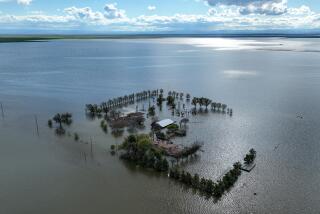Data Shows N. California Was 72% Wetter in 1400s
SAN FRANCISCO — Northern California, the source of most of the state’s fresh water and the site of a protracted debate on the use of that resource, was a much wetter place 550 years ago, but scientists do not know why precipitation has dropped by 72% since then.
Runoff toward San Francisco Bay, which drains 40% of California’s land area, has dipped to 38,500 cubic feet per second from an ancient zenith of 140,000 cubic feet per second or more, Bay Area geologists said Tuesday at a meeting of the American Geophysical Union.
The scientists, headed by B. Lynn Ingram of the Lawrence Livermore National Laboratory, noted that the amount of fresh water that actually reaches the bay is only about half the 38,500 figure because the flow is diverted for use by farms and cities.
Ingram, along with colleagues Donald J. DePaolo of UC Berkeley and James C. Ingle of Stanford University, has reconstructed freshwater flows toward the bay by estimating ancient salinity levels as indicated by clam, mussel and oyster remains buried in bay sediment.
The scientists measured the ratio of two strontium isotopes--different forms of the same element in the bivalves. Since fresh water and seawater have different ratios of isotopes, the researchers were able to determine the environment in which the animals lived.
“This technique is a viable means of getting a long-term picture of what river flow was like in the past, and thus what water resources were available in the state historically,” Ingram said.
Ironically, the conclusions drawn from moldering mollusks may well affect a contemporary fight over water rights.
Agricultural water interests in Central and Southern California have argued that cutting back on allocations for growers to create additional river flows toward the bay should not be made to maintain freshwater natural habitats because the bay never received significantly more fresh water than it does now.
At state hearings in the mid-1980s to reconsider historic water rights in the north half of the state, growers said that natural wetland vegetation had soaked up a significant share of river flows before they reached the bay.
The team’s data seems to contradict that theory and supports the argument of environmentalists and sportsmen who contend that giving farms and cities more of what little fresh water is left will accelerate a measurable decline of the bay and delta habitat.
That decline has been inferred from salinity studies and significant damage to salmon, striped bass and other fisheries in the bay and the Sacramento River system.
However, the data undermines environmentalists’ assertions that federal and state water projects are primarily to blame for reducing river flows to the bay. The data suggests that the region simply does not get as much rain and snow as it once did, even in non-drought years.
Based on their estimates of historic water flow through the delta formed by the confluence of the Sacramento and San Joaquin rivers, the team calculated that average precipitation 200 to 600 years ago was twice or more what it has been in non-drought years this century.
Their results also indicate that precipitation historically fluctuated in an approximately 200-year cycle, although the geologists emphasized that their sediment dating was not accurate enough to predict whether that cycle is continuing or where the state might be in the cycle.
Using bay sediments to estimate prehistoric precipitation provides valuable new data that is not easily obtained from tree-ring studies, a more traditional source of information.
Tree-ring studies require ancient trees. But the Sacramento and San Joaquin drainages have been heavily logged by timber companies, railroads and farmers since European settlers arrived in large numbers after 1850.
Ingram said there are few trees with good growth rings in the area that feeds water to the bay.
“Water resources are a problem everywhere, which makes records of past precipitation and stream flow critical for assessing future water availability,” DePaolo said. “Our method should be applicable in many estuaries around the world (where) there are no other ways to get this information.”
Ingram and DePaolo, along with three additional collaborators, are already working on refining their paleoclimatic assessment.
The current version looks at 50-year averages of river flow and has difficulty accurately assessing the flow after it was disturbed by dams, diversions and other human activity.
More to Read
Sign up for Essential California
The most important California stories and recommendations in your inbox every morning.
You may occasionally receive promotional content from the Los Angeles Times.









